|
Lancia, one of the most famous and evocative of all the
major automotive brand names, has just arrived at its
centenary. To celebrate this milestone Italiaspeed is
presenting an exclusive 15 part history of Lancia.
Despite the
cessation of the sportscar campaign, Gianni Lancia’s
decision to press ahead with the company’s involvement in
motorsport was not made without dissent in some quarters. In
The Shield and Flag, Nigel Trow notes that, “There
was always a certain internal opposition to Gianni’s
expensive racing programme and the increasing costs of
commercial expansion and the (newly-commissioned Lancia
skyscraper) must inevitably have caused friction within the
administration.” It was argued by some that with the factory
at full capacity, an investment in extra production
capability may have been a wiser investment. On the other
hand, however, having come so far with the investment,
Gianni may have reasoned that it was folly to pull out just
at the point of a potential return; and there was no reason
to suspect that the success of the production side of the
business was to fall away any time soon.
Thus Lancia took
the decision to commit to a full involvement in Formula
1. In fact, some sources suggest that design on the new
single-seater had first commenced at the close of 1952,
alongside the development of the sports racers, although the
decision to press ahead with the programme would not come
until August 1953. Given Lancia’s size and the extent of the
engineering talent available, it is no surprise that many of
the same names appear on the roll-call for both
programmes. According to Chris Nixon in Rivals: Lancia
D50 and Mercedes-Benz W196, responsibility was assigned
to Ettore Zaccone Mina on the engine side, Luigi Bosco for
the transmission, and Francesco Faleo for the chassis,
suspension and brakes, with overall responsibility for the
project assumed by Jano. In this context, Zaccone Mina
observes that, “Jano was the leader of the team, but he was
not THE designer! No one person was responsible for the
overall design of the car...these things all came out of
discussions between us, with Gianni Lancia making the final
decisions.” The manager of Scuderia Lancia, Attilio
Pasquarelli, would also turn his attention to the new
programme.
With the 1954
Formula 1 season heralding a change of regulations, allowing
naturally aspirated engines of 2.5-litre capacity, the new
Lancia racer was one of two cars (the Mercedes-Benz W196 was
the other) designed specifically to fit the new formula. In
typical Lancia fashion, the D50 contained engineering
solutions which were genuinely innovative for the
period. All-up, the car weighed just 610kg – lightness had
been a priority for the designers, with the elimination of
excess weight through unneeded structural elements extending
to the fact that the bottom rails of the chassis doubled up
as oil pipes. The engine, too, was ahead of its time –
unusual in employing a V8 layout, the first such in post-war
Grand Prix racing. An all-alloy 2.5-litre quad-cam unit
originally rated at around 230 bhp – a modest amount by the
standards of the day – it featured carburetion by four
twin-choke Webers (soon changed for Solexes), surge-proof
hairpin valve springs, twin Marelli magnetos, lightweight
finger tappets beneath asymmetrical camshafts, a
close-contoured dry sump and externally-stiffened block.
The most
noteworthy feature of the compact V8, however, was in
forming a load-bearing part of the car, more than a decade
before the Lotus 49. As a bolt-in component, the tubular
upper wishbones of the front suspension (sprung by a single
transverse leaf) attached to the cylinder heads, whilst a
spaceframe linked it to the transaxle at the rear. As with
the rest of the car, detail engineering abounded throughout,
such as the front end’s inboard dampers, actuated via
drilled rocker arms.
The concept of
the engine forming a structural part of the car was not new,
but in the D50 it was taken to a new level – the tubes which
ran underneath the engine did not significant stress under
load, and only served to support the chassis if the engine
needed to be removed from the car. For all that, though,
Graham Howard has suggested that the importance of the
engine as a stressed member is over-emphasised: “While the
bolt-in engine undoubtedly helped chassis stiffness and
saved a marginal amount of weight, Jano blithely left the
spacious cockpit bay quite open on the top surface. If we
were to imagine Jano thinking his car over, we could easily
see him recognising that he was trying to get the tightest
possible bodywork wrapped around an irreducible
cross-section of V8, and then deciding to make the engine
work for him, rather than against him. After all, bolted-in
engines had been used as cross-members in the pressed-steel
chassis days of the ’20s...(in short, it) looks more likely
to have been Jano making a virtue of necessity.”
The 90-inch
wheelbase was identical to that of the Maserati 250F and
most other competitors, and the track (49in) was likewise
in-line with the rivals’ measurements. As L.J.K. Setright
notes, however, “the D50 looked wider because, with the
engine and driveshaft inclined at 12 degrees to the car’s
longitudinal axis, the driver (with the shaft passing from
right to left across his left hip) sat lower than most”,
which reduced frontal area. The steering system designed by
Gillio was also unusual – it had a very short shaft,
designed to minimise inaccuracies caused by torsional
movement, connected to the steering box which joined to a
vertically-set bell crank, operated by a split track rod.
In practice, says Trow, “it proved light and accurate...it
also did away with the need for heavy universal joints.”
More
unconventional thinking was to be found at the rear of the
car – although it shared with the Maserati and Ferrari a de
Dion rear end and transaxle configuration, the D50 was alone
in grouping the clutch with the gearbox and (ZF
limited-slip) differential, as exemplified on the roadgoing
Aurelia. This did not stem merely from a desire to be
different – the solution improved the gearchange quality by
eliminating the inertia of the propshaft on the gearbox
input shaft. The transmission itself was a five-speed unit,
with synchromesh on the top four gears. Early in the design
process, a sequential gearbox had also been envisaged,
although such a feature would never see the light of day;
the same fate would also befall the similarly-envisioned
direct fuel injection and driver-engaged four-wheel drive.
Inboard brakes, as seen on the marque’s sportscars, were
also rejected, although it is generally stated that this was
due to a lack of space; the resulting outboard items were
twin-leading-shoe drums all around.
But even minus
these innovations, the D50 stood out – as with the sports
racing cars which preceded it, it was different to the
hordes, just different enough to be ‘acceptably Lancia’. To
most observers, nowhere was this more evident than in its
extraordinary, forward-looking appearance. With outboard
pontoons filling the space between the wheels on either
side, the D50 certainly looked unique – short and squat,
David to the Mercedes-Benz W196’s Goliath (although as noted
above, this was largely an optical illusion). The panniers
were not a new idea, but had remained dormant since the
principle was employed on Henry Seagrave’s 1929 land-speed
record breaker, Golden Arrow, and then on a few Austins and
Singers at Brooklands in the 1930s. On the Lancia, however,
they served a dual function – in addition to their
aerodynamic virtues (filling what would otherwise have been
an area of turbulent air and reducing drag), they served as
fuel tanks. With a third tank placed at the rear, behind
the driver, this allowed for the weight distribution to be
kept constant around the middle of the wheelbase throughout
a race – an important consideration when the difference in
weight between the start and finish of a race could be as
much as 300lb.
Publicly
presented for the first time at Turin’s Caselle Airport in
February 1954, what sort of car the D50 was is perhaps best
summed up by Howard, who wrote that, “compared against the
pure-engineering style of the Mercedes, Jano’s Lancia was
clearly in the Italian heritage – it was a 1950s evolution
of all the things considered to be best for an Italian
racing car. By no means is this meant to suggest the D50 was
outdated, because by Italian standards it clearly was the
most advanced car of them all, and indeed on lap times it
was superior to the Mercedes as well. But where the Mercedes
combined at one stroke, desmodromic valve operation, true
space-frame chassis, and above all massive technological and
financial commitment, Lancia embodied traditional thinking
further developed.”
That
presentation and shakedown in January had been accompanied
by an announcement that Alberto Ascari and Luigi Villoresi
had left Ferrari to join the new équipe. But while
the car was originally entered for the first European round
of that year’s World Championship, the Belgian Grand Prix at
Spa, held in June, it proved a no-show, along with the other
hotly-anticipated newcomer, the Mercedes-Benz W196. However,
while the Germans made a successful debut at the next round
of the championship in France, Lancia again failed to show,
a pattern which would be repeated for the rest of the
championship – crowds at Silverstone, the Nürburgring,
Bremgarten and Monza would all be disappointed.
Gianni Lancia
finally gave the go-ahead when at a private test session at
Monza following the Italian GP, Ascari had managed a record
lap of 1:56.0, three seconds faster than Fangio had managed
in the streamlined W196 and that amount faster than Ascari
himself had managed with a Ferrari. The car’s innovative
nature was certainly responsible for a good chunk of the
delay, with the engineers taking their time to resolve the
numerous challenges involved, including a complete redesign
of the engine’s valvetrain. It also didn’t help that Lancia
was operating without the vast technical resources at the
disposal of the Stuttgart operation, or indeed that the
limited resources which were available had to be shared with
the ongoing development for the sportscar programme. But
when the car finally made its belated debut at the final
round of the championship, the Spanish GP at the Pedralbes
circuit in October, it was obvious that the extra
development time had been well-spent.
After a dominant
performance in practice, Ascari claimed pole position, a
second faster than Fangio’s Mercedes-Benz, with Villoresi in
the second D50 qualifying fifth. In the race itself, Ascari
simply drove away from the field, taking the lead after a
couple of laps and establishing a 20-second lead when he was
forced to retire due to an oil-drenched clutch after only 10
laps, caused by a faulty casting (Villoresi had already long
since retired with brake problems). The performance,
including setting the fastest lap, was impressive enough to
drive Rodney Walkerley, writing in The Motor, to
describe the Lancias as “rockets on wheels”.
In fact, apart
from the new car’s obvious potential, there was another
reason for Ascari’s pace. The Italian had started the race
on half-tanks, planning to build enough of a lead to come in
and refuel, on account of the car’s small fuel tank not
being able to hold enough for a full race distance. But it
had another consequence. Despite the attention to detail
paid regarding the effect of the fuel-filled panniers on
handling, Jano’s team had not fully resolved the handling
issues evident when their drivers were on the limit. With
the pontoons housing the bulk of the fuel load, the car’s
weight distribution was, to say the least,
unconventional. This in turn gave it very low polar moments
of inertia in yaw and pitch, but a high one in roll,
“calling for firm suspension and making it interesting that
the rear dampers were connected by a balance beam so as to
be ineffective in roll”. This solution would make for
jittery handling on a full fuel load and was a problem that
Lancia themselves never fully resolved, although it is noted
in The Racing Car: Development and Design by Cecil
Clutton, Cyril Posthumus and Denis Jenkinson that
modifications were incorporated, aimed at reducing the
cornering power of the rear wheels. In the original car, the
cornering power of all four wheels was almost identical,
“with the result that the driver had little warning of the
limit being reached until he was spinning off the road”. It
has been hypothesised that the equal-length, parallel
wishbones employed by Lancia may have contributed to the
problem, by not allowing for a small amount of negative
camber on the heavily-loaded outer wheel.
It has been
suggested, notably by L.J.K. Setright, that although it ran
on Pirellis, the best tyres then available, the D50’s
handling characteristics required tyre technology not
developed until 1960 to be fully exploited. Regardless,
writing with the benefit of hindsight, Setright offered a
different explanation for the unpredictable behaviour of the
early D50s, centering on the linkages locating the de Dion
axle beam. The paired radius rods providing fore-and-aft
location on each side of the chassis, he writes, were
“actually rather special...convergent and unequal in
length...the lateral location was by interaction between a
slot and a peg on the axle, and finally the telescopic rear
dampers were linked by a balance beam so that they had no
effect in roll, damping the transverse leaf spring only in
the bump mode.”
It was a novel
solution, but although it sometimes worked, it sometimes did
not, and it was this unpredictability which garnered the D50
a reputation as a difficult car for all but the very best
drivers to get the most out of – and sometimes, even the
likes of Ascari could not be sure which way the car would
react. The reason is clear enough if we take Setright’s
suggestion and focus closer attention on the radius arms.
As he puts it, whenever the car rolled laterally (as in
cornering or a single-wheel bump), “the arms would try to
twist the dead axle beam, which would react as though it
were an impossibly stiff anti-roll bar. Maybe that was why
the dampers’ contribution to roll resistance was excluded,
but it was also necessary to put flexible joints at the rear
ends of the radius arms and these had their own parasitic
effects on springing and damping. When compressed, they
would react after a finite but unpredictable delay, urging
the axle back whence it came, and this might just have been
a manageable characteristic were it not for those pontoons
full of fuel on each flank of the car.” With a full load,
the effect was to give the whole sprung mass a very high
moment of inertia in roll, “making the car as a whole slow
but emphatic in this motion when everything else in it was
designed to make it quick and corrigible.”
All of this
helps to explain why, in the early stages of its career, the
D50 was exceptionally quick in practice or when running with
a small fuel load. With a reduction in both rolling moment
and roll couple, as well as a lowered centre of gravity
closer to the roll axis, the car became, “as prompt and
predictable in roll as it was naturally in pitch and in
yaw.”
With the cars
modified over the winter break and now dubbed D50A, Lancia
headed to the non-championship Argentine GP in January 1956
with positive hopes, having recruited Eugenio Castellotti
from their sportscar programme to drive a third entry
alongside that of Ascari and Villoresi. The cars never
displayed the handling balance evident at Barcelona,
however, with Ascari spinning six times in practice.
Curiously, it did not seem to affect their overall pace
unduly, with Ascari second-quickest in practice behind
Gonzalez’s Ferrari, and Villoresi 11th. But the
unpredictable handling would again bite in the race, with
Ascari crashing out of the lead on lap 22, and Villoresi
doing likewise a few laps later in Castellotti’s car, which
he had taken over after his own car broke a fuel line on lap
12.
The Valentino
Grand Prix, on a street circuit in the Parco Valentino in
Turin, marked the next appearance for the Grand Prix Lancias
and on home ground the cards finally fell the D50s’ way. A
couple of months had elapsed since the Argentine debacle and
the time had been used to further develop the cars; the
factory was rewarded with pole position and victory for
Ascari, fending off challenges from the Ferrari and Maserati
teams, backed up by Villoresi and Castellotti coming home in
third and fourth, split by Roberto Mieres’ Maserati. At
another tight and bumpy street circuit – Pau, in France –
Ascari looked set for another win when a brake pipe broke.
After repairs, he finished fifth, behind Villoresi and
Castellotti in second and fourth.
|
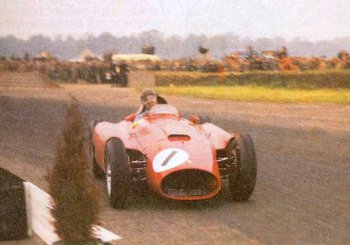 |
|
In 1956, the record books show that the newly-dubbed
Lancia-Ferraris, aided by a driver lineup which
incorporated the likes of Fangio, Peter Collins and
Luigi Musso, would have a relatively comfortable
time of it, despite strong competition from Stirling
Moss, now at Maserati. Photo: Fangio in action at
the 1956 British GP. |
|
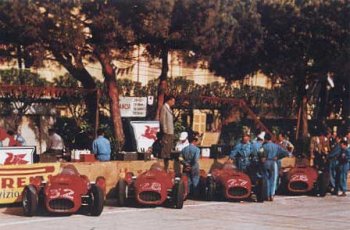 |
|
The most noteworthy feature of the D50's compact V8,
however, was in it forming a load-bearing part of
the car, more than a decade before the Lotus 49.
Photo: Line-up of D50s at Monaco in 1955. |
|
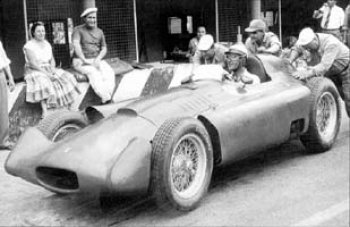 |
|
A special Lancia D50 dubbed as the ‘Streamline’ was
used in practice at the 1956 French Grand Prix at
Reims; however it never raced. |
|
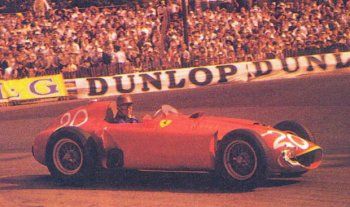 |
|
Fangio with a rather battered Lancia-Ferrari D50
during the 1956 Monaco GP; he would later take over
Collins’ car to finish the prestigious race second. |
|
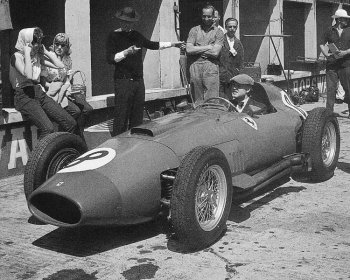 |
|
Mike Hawthorn sitting
in the cockpit of the Lancia-Ferrari 801 during the
practice session at the 1957 German Grand Prix. |
|
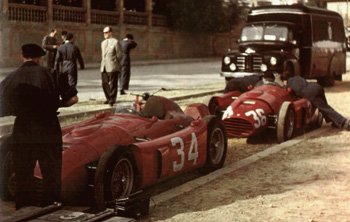 |
|
The Lancia D50s of Ascari and Villoresi on the
occasion of the much-delayed debut of the new racing
car at the Spanish Grand Prix in October 1954. |
|
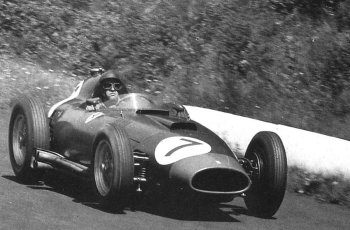 |
|
Peter Collins charging
hard at the wheel of the Lancia-Ferrari 801 at the
Nürburgring during the 1957 German Grand Prix. |
|
|
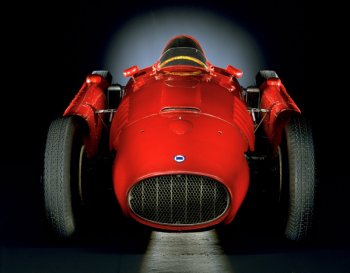
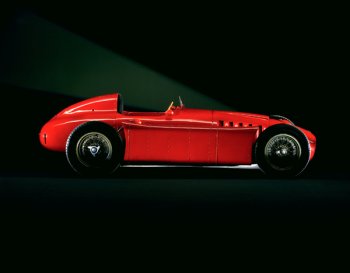
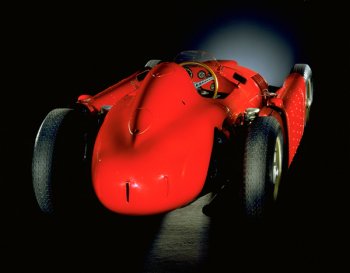 |
|
With the 1954 Formula 1 season heralding a change of
regulations, allowing naturally aspirated engines of
2.5-litre capacity, the new Lancia racer was one of
two cars (the Mercedes-Benz W196 was the other)
designed specifically to fit the new formula. |
|
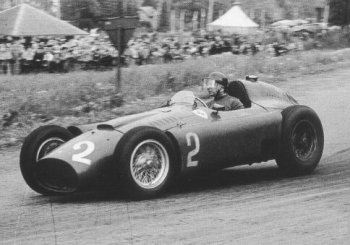 |
|
In typical Lancia fashion, the D50 contained
engineering solutions which were genuinely
innovative for the period. Photo: Fangio rounding La
Source at Spa in the Lancia-Ferrari D50 (1956). |
|
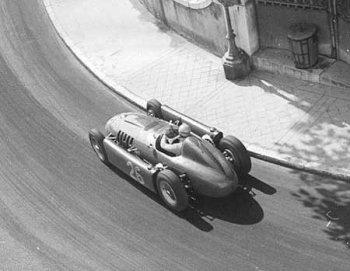 |
|
Ascari (above) at
Monaco in 1955, shortly before his crash into the
harbour. Coming out of the tunnel at an almighty clip –
Ascari was pushing hard; he flew through the hay
bales and careered into the harbour with wheels
locked, a gush of steam emanating from the point
where the Lancia hit the water. |
|
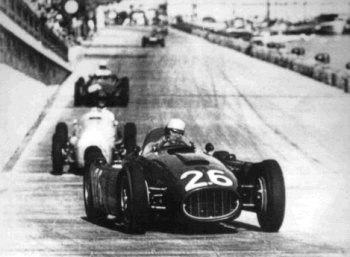 |
|
The resulting sale of the company to industrialist
Carlo Pesenti towards the end of 1955 had
necessarily meant a total withdrawal from racing;
the company’s precarious financial position demanded
such an outcome.
Photo: Ascari in action during the 1955 Monaco GP. |
|
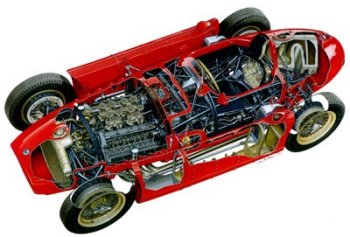 |
|
The Lancia D50's engine was ahead of its time –
unusual in employing a V8 layout, the first such in
post-war Grand Prix racing. |
|
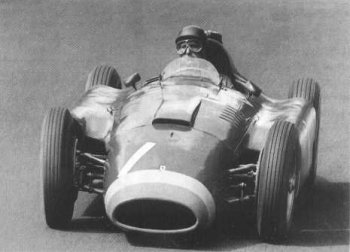 |
|
With outboard pontoons filling the space between the
wheels on either side, the D50 certainly looked
unique – short and squat, David to the Mercedes-Benz
W196’s Goliath. Photo: Fangio in action in the
D50. |
|
|
A further street circuit outing in Naples a month later
yielded first and third for Ascari and Villoresi. The omens,
for both pace and reliability, were thus promising for the
clash, in late May, with the might of Mercedes in Monaco,
the first time the principality had held a Grand Prix since
1950. The lineup was boosted by the addition of Louis
Chiron, who had won the Monte Carlo Rally at the wheel of an
Aurelia B20 the previous year. The cars had also undergone a
further round of revisions, majoring on the oil cooling
system. Practice was encouraging, with Ascari setting the
fastest practice lap, equal with Fangio, and lining up
alongside him at the front of the grid. Castellotti would
start right behind his team leader in fourth, with Villoresi
seventh and Chiron in 19th. After the mêlée of the first few
laps had settled down, the order ran Fangio from Moss,
leading the two Lancias of Castellotti and Ascari. The
Italians were under pressure from Jean Behra’s Maserati, who
eventually found a way past both on lap 17.
Having settled
into something of a rut, the race suddenly came alive at
around half-distance. Behra had pulled out a decent lead
over the two Lancias but a long pitstop on lap 42 cost him
two laps and any hope of a good result; Castellotti was also
forced to stop to change a front wheel soon afterwards. But
the race took a particularly interesting twist when the
leader, Fangio, broke his propshaft. Moss took over the
lead, and seemed safe as the Lancias were starting to suffer
from fading brakes – his lead over Ascari in second place
measured nearly a full lap. But then, with the sort of twist
for which Monaco is renowned, Moss blew his engine on the
82nd lap.
Had but Ascari
been aware. Coming out of the tunnel at an almighty clip –
Ascari was pushing hard to avoid being lapped by the
Mercedes – and close to taking the lead, the red car missed
the chicane, flew through the hay bales and careered into
the harbour with wheels locked, a gush of steam emanating
from the point where the Lancia hit the water. To everyone’s
relief, a helmet broke the surface of the water soon
afterwards; with that resolved, attention focused once again
on the race.
The demise of
Moss and Ascari had gifted Maurice Trintignant and his
rather outdated Ferrari the lead, with Castellotti in hot
pursuit, mechanical maladies now remedied. The Lancia was,
in fact, closing on the Ferrari at the rate of about a
second a lap; but a spin at the Gasworks convinced him to
slow down and settle for second place. Villoresi and Chiron
came home in fifth and sixth to complete a reasonable outing
for the D50s – even if the team was entitled to feel a
little disappointed with the final result.
It was of course
a positive that Ascari, who put his accident down to oil on
the circuit, escaped from his dunking unscathed apart from
some bruising and a broken nose, but the incident would not
have failed to shake him. It was a supreme irony that his
luck would run out just four days later, killed testing a
Ferrari sportscar at Monza when he crashed at the Curva del
Vialone. It was the 26th of May, 1955.
Plunged into
crisis, Lancia took the ultimate decision to cease all of
the company’s racing activities forthwith. It was a terrible
blow; with Gianni’s enthusiastic backing, the early fifties
had seen the company make a heavy commitment to motorsport
at all levels – from production models prepared for use in
competition, to dedicated racing cars, and without
exception, the results had been outstanding. But such a
weighty devotion to sporting activities had taken its toll
on the company’s finances, for the continued success in
competition was simply not being repaid with a commensurate
return. Before the curtain came down, however, there would
be one last hurrah – and it is one which provides for a
fascinating ‘What if?’ in Italian automotive history.
The loss of
Ascari had devastated the racing team and, Setright says,
“seems finally to have prompted Lancia to retire.” It was
the culmination of a perfect storm of increasing pressures,
all of which had contributed to making the motor racing
programme seem an increasingly indulgent luxury – the
increasing financial difficulties; dissent between the
family over where to direct investment; ever-more searching
questions from some within the company about the value of
the racing programme, which the loss of their star driver
had only compounded; and the repercussions of that year’s Le
Mans tragedy, which had resulted in the cancellation of
almost all continental European motor racing.
The resulting
sale of the company to industrialist Carlo Pesenti towards
the end of 1955 had necessarily meant a total withdrawal
from racing; the company’s precarious financial position
demanded such an outcome. Nevertheless, as Setright
observed, “It could not...possibly mean the destruction of
all that had been made, the denial of all that had been
achieved and all that was yet promised. That disaster was
avoided: negotiations between Lancia, Ferrari, and Fiat,
resulted in Fiat paying Ferrari £30,000 a year (guaranteed
for five years)...to take over and run the Lancia GP
organisation.” This much is well-known; on July 26, 1955,
exactly two months after Ascari’s fatal accident, all the
team’s cars, engines, drawings, transporter and parts
(including a partially-finished ‘streamliner’ body designed
for the Italian GP at Monza) were handed over to Maranello,
along with their designer, Jano.
Yet what remains
less recognised is the twist of fate which allowed for the
collaboration between Lancia and Ferrari. Once again,
Setright takes up the story: “How quickly the car settled
into its winning ways was remarkable as early in practice
for the Belgian GP in June, when Fangio lapped the daunting
Spa circuit in 249.8 seconds to average 203.49 km/h (126.4
mph). Not only was that 8.8 seconds faster than he could
manage a year earlier in the Mercedes-Benz, it was also 4.9
seconds faster than Moss in the latest Maserati which had,
like the Lancias, enjoyed a year of development in the
interim. Maserati engineers might well have wondered whether
they had been right to assert, a year earlier, that their
car was basically better than the Lancia; had they not taken
such a stand, Fiat might well have presented the Lancia
outfit to Maserati – and then what would history have
done?”
So much for
speculation. Having acquired the Lancias in fortuitous
circumstances, Ferrari – who had threatened to pull out of
Formula 1 the previous year if he did not secure a
substantial backer – was not about to look a gift horse in
the mouth. But neither was he prepared for Lancia alone to
take the credit. Setright notes that Ferrari “promptly set
about altering them until they were as little like Jano’s
original ideas as possible”, despite Jano arriving in
Maranello along with the cars – but whatever the
effectiveness or otherwise of the various modifications, the
modified D50s were to enjoy no small amount of success in
1956.
In the interim,
the D50s had remained largely dormant. Castellotti had
managed to persuade Gianni Lancia to send a private entry,
albeit with works support, to the Belgian GP, which he then
proceeded to qualify on pole with a record lap – a truly
remarkable achievement given the immensely fast nature of
the Spa circuit and the D50’s very low polar moment of
inertia. In the race, he would run in third place, behind
Fangio and Moss, before gearbox failure accounted for his
retirement at half-distance.
Under new
management, a couple of D50s were entered by Ferrari in the
Oulton Park Gold Cup in September, largely unmodified from
the form in which they ran at Spa. Hawthorn and Castellotti
acquitted themselves well, with the Brit claiming second
place. But in their only other championship appearance that
year, the Lancias would not have such a good time of it.
The final round
of the 1955 World Championship was held at Monza, and marked
the first use of the venue’s famous banking. Unfortunately,
this was to prove the Lancias’ downfall, although the cause
was completely outside their control. The banking proved
brutal for all but the best tyres, and Ferrari’s binding
contract with Englebert did not give provision for the
newly-acquired Lancias to run on their favoured
Pirellis. The tortuous nature of the banking on tyres
wrought havoc on the Belgian rubber, leading to a plague of
thrown treads, including a big crash for Giuseppe
Farina. That incident led to Farina and Villoresi being
withdrawn and Castellotti reverting to a Ferrari Supersqualo.
Setright notes that Ferrari’s drivers were, “even more
unhappy with the vicious understeer of the existing (Supersqualos)
than Lancia’s men had been with the jittery D50”, but were
left with little choice as a result of the tyre failures. It
was an especial shame given the fact that not only was the
D50 was the only car remotely capable of challenging the
Mercedes-Benzes, the Ferraris were so woefully
uncompetitive. For Enzo, Lancia’s withdrawal and the
handover could not have come at a more opportune time.
The playing
field would alter dramatically with the withdrawal of
Mercedes from Formula 1 at the end of that race at Monza, a
decision prompted in part by the disaster at Le Mans. In
1956, the record books show that the newly-dubbed
Lancia-Ferraris, aided by a driver lineup which incorporated
the likes of Fangio, Peter Collins and Luigi Musso, would
have a relatively comfortable time of it, despite strong
competition from Stirling Moss, now at Maserati. Excluding
the Indianapolis 500 (then a part of the World
Championship), Fangio took six pole positions from a
possible seven. These were backed by race results: D50s
claimed five championship race wins that year, in Argentina,
Belgium, France, Great Britain and Germany, plus two
non-championship wins for Fangio in Buenos Aires and
Syracuse. Fangio would claim the title in the final race of
the season, the Italian Grand Prix, after Collins loyally
handed over his car to the Argentinean, who went on to claim
his fourth consecutive world championship.
Modifications to
the cars during the season had kept them competitive in the
face of continued development of rivals, most prominently
the 250F. These changes included variations in the engines’
bore and stroke, unequal-length wishbones (to help cure the
twitchy on-the-limit handling), and forged steering arms. By
the beginning of the European season, the chassis had been
significantly revised to a more recognisably Ferrari design
– the entire fuel store had been moved to an elongated tail,
with the pontoons (now faired into the bodywork) merely
serving aerodynamic purposes. Moreover, the change from
Lancia telescopic dampers to Ferrari’s preference, Houdaille
vane-type items, was made more significant by the fact that
they were now attached directly to the de Dion beam, thus
restoring their effectiveness in roll. Finally, Lancia’s
original, highly rudimentary, exhaust system was also
replaced by a longer and more sophisticated item, which
worked better in conjunction with the V8’s 90-degree
crankshaft and, along with developments in fuels, was an
important factor in raising the engine’s output to as much
as 280 bhp by 1957.
But Trow writes
that for one reason or another, Ferrari did not maximise the
D50’s development potential, nor the presence of Jano. He
observes that, “It seemed that no one liked Jano’s stressed
engine and they added many extra supports to the front of
the car to relieve it...no one seems to have asked Jano what
he thought about this, and they seem also to have ignored
the advantages of his design.” The somewhat arbitrary nature
of some of these changes was reflected in the results – for
instance, it did not escape notice that at the
season-opening Argentine Grand Prix, where Ferrari had
entered five cars of varying specification, Fangio had won
in the car closest to the original Lancia specification...
Frustrated with
inter-team machinations, Fangio departed for Maserati at the
end of the season, but good results nevertheless continued
into the first half of 1957, with the original design now
sporting a sprinkling of further Ferrari-induced
modifications and renamed ‘Lancia-Ferrari 801’, now minus
side pontoons. Collins won at the non-championship Grand
Prix of Naples and Syracuse Grand Prix, and Luigi Musso took
victory at Reims in the non-championship GP de Marne, held a
week before the French GP, in which he headed a
Lancia-Ferrari 2-3-4 behind Fangio’s 250F. This result would
be repeated in the famous German GP of that year, in which
Fangio fought back from a slow pitstop to reclaim the lead
and claim his fifth world championship. But despite its
enduring competitiveness, a combination of new regulations
and Enzo Ferrari’s unhappiness with running the D50s over
‘pure’ Ferraris meant that the writing was well and truly on
the wall. The cars’ final appearance would, appropriately
enough, be the championship-closing Italian Grand Prix at
Monza, where Wolfgang von Trips closed out the car’s career
with a podium finish, inheriting third when first Collins
and then Hawthorn encountered mechanical maladies. The final
scoresheet for the D50, in little over two-and-a-half
seasons of competition, showed nine victories and nineteen
fastest laps (including both practice and the races
themselves).
For Ferrari, who
had never taken kindly to the idea of running the D50s as
his own cars, the opportunity to whitewash the Lancia from
history could not come soon enough. By 1957, Enzo had,
“already had the Lancia name expunged from its engine
castings and identity papers; all that remained, at the end
of the year, was for the six cars that had come into his
hands to be destroyed.” Later, this same trait would extend
to him arranging for Collins’ beloved Flaminia road car to
be part-exchanged for a 250GT convertible, as he wanted his
drivers to be seen in the company’s own product. Not
including the recently-constructed replicas, only two
original D50s still survive.
From this point
on, once again, the only Lancias in competition would be
private entries, although this did not diminish the level of
success. With the Aurelia B20 now approaching the end of its
life, it was left to the little Appia to uphold marque
honour. In its GT Zagato version, it was virtually
unbeatable in the 1150cc class, and various iterations of
Appia continued to claim class wins in the Mille Miglia,
Carrera Panamericana, Liège-Rome-Liège and Targa Florio. Due
to the deadly accidents at Le Mans and the Mille Miglia in
1955 and 1957 respectively, the Florio was turned into a
regularity run for small saloons in 1957, and in this
situation Taruffi nearly claimed an outright victory in an
Appia, finishing second to Colonna’s Fiat 600. In 1959, the
Flaminia Sport Zagato appeared, which saw a repeat of the
Appia’s success, this time in the 2500cc class. But these
successes, although noteworthy, were relatively small-scale.
It would not be until the mid-sixties that Lancia would
again attain serious international competition success, this
time in the field in which it would make its name –
rallying. In the meantime, Pesenti was left with the job of
rebuilding a shattered company and restoring it back to
health with a range of viable new road cars.
by Shant Fabricatorian
|
|
|
|